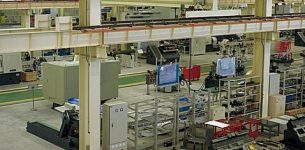
Shenyang Machine Tool Expands the Use of TURCK BLident Radio Frequency Identification System
[ad_1]
Traditional tool management mainly relies on lettering or the code disc on the tool holder to identify, manually enter information, and track, measure, and record the tool.
With the improvement of processing efficiency and automation and more frequent tool changes, this traditional method of manually tracking tool information has been difficult to meet the current processing requirements for tool information. Therefore, an automated tool identification system (RFID) is needed. The tool itself carries an RFID code carrier, and a reader is installed in an appropriate position to identify and monitor the tool, and to track the position and information of the tool in real time.

Shenyang Machine Tool (Group) Co., Ltd., as my country’s largest machine tool manufacturer and CNC machine tool development and manufacturing base, Shenyang Machine Tool has a glorious history: the Republic’s first ordinary lathe, the first horizontal CNC lathe, the first A radial drilling machine, the first horizontal boring machine and the first automatic lathe were all born here, and Shenyang is therefore known as the “hometown of machine tools” in China. Develop new products based on major technical and equipment needs in key areas of the national economy. At present, CNC machine tools provided for key industries such as automobiles, aerospace, defense and military industry, rail transit, shipbuilding and other key industries account for more than 70% of the total sales of CNC machine tools, and some of them have replaced imports. .
Traditional tool management mainly relies on lettering or the code disc on the tool holder to identify, manually enter information, and track, measure, and record the tool. With the improvement of processing efficiency and automation and more frequent tool changes, this traditional method of manually tracking tool information has been difficult to meet the current processing requirements for tool information. Therefore, an automated tool identification system (RFID) is needed. The tool itself carries an RFID code carrier, and a reader is installed in an appropriate position to identify and monitor the tool, and to track the position and information of the tool in real time.
For Shenyang machine tools, we expanded the TURCK BLident radio frequency identification system on the basis of the existing workshop control system.
System extension 1: FANUC CNC system + TURCK TIBL67-PG-DP-2
The FANUC CNC system communicates with the TURCK RFID system through the PROFIBUS-DP protocol, and the upper system can drive the on-site reader to read and write the code carrier.
System extension 2: SIEMENS CNC system + TURCK TI-BL20-GW-DPV1-2
The SIEMENS CNC system communicates with the TURCK RFID system through the PROFIBUS-DP protocol, and the upper system can drive the on-site reader to read and write the code carrier.
System control principle: TURCK RFID readers are installed in maintenance rooms, warehouses, workshops, and production lines. When the tool with RFID carrier moves to this area, the RFID carrier is read through the reader and the tool is updated in time The working status and location of the system to the background system terminal.
Tool registration: Each set of new tools must be loaded with a code body, and ID registration must be carried out, and the corresponding information of the tool will be written into the code body carried by the tool through the reader, such as name, model, warehouse area Locations and so on.
Machine tool equipment number: Install a fixed reader/writer on each working machine tool. Each reader/writer has a number and is bound to the machine position. Each time the reader reads the tool code body, it will The tool position status is updated in the background database.
Tool out of library: There is a reader at the door of the tool storehouse. When the tool passes through the door, the reader reads the tool carrier and feeds back the information that the tool has been out of the library to the back-end database.
Tool on the machine: Before the tool is on the machine, read the tool code body through the reader on the machine tool, and feed back to the database that the tool has been on the machine on the machine.
Tool off the machine: After the tool is finished working, use the reader to read the code carrier, and the system will mark in the database corresponding to the tag that the tool has finished working in the bed.
Tool return to the library: When the tool enters the library through the door, the code carrier is read through the reader, and the system knows that the tool has been returned to the library.
Tool maintenance: If the offline tool is damaged and needs to be repaired, when entering the entrance of the repair room, the reader will read and write the code body information to inform the system that the tool is under repair, and prompt the staff to enter the necessary repair information and estimated repair time .
Tool storage: The staff can use the hand-held reader to perform regular storage, read the tool carrier information at close range, and compare it with the back-end management system, and manually check whether the variety and quantity of the tools in the location are consistent with the back-end system. If they are inconsistent, the system information can be corrected on site. This inventory method can shorten the enterprise inventory time by 85%, greatly improve work efficiency, and at the same time increase the inventory cycle.
The benefits of RFID to customers
In inventory management, there are many types of tools, huge numbers, and frequent warehousing operations. Without effective and reliable identification technology, inventory management can easily fall into chaos. The tool’s radio frequency identification system greatly improves the efficiency of tool management, greatly improves the performance and life of the tool, reduces manufacturing costs, and improves productivity and processing quality.
[ad_2]




